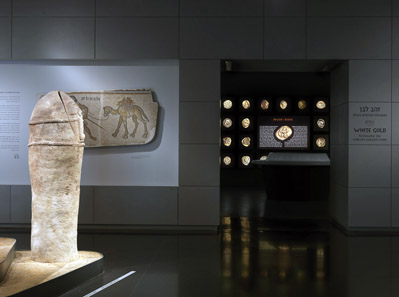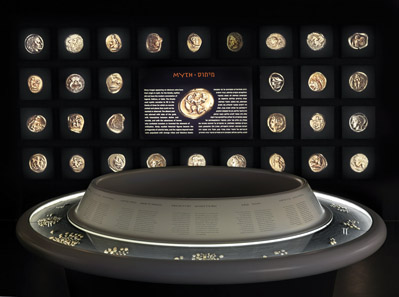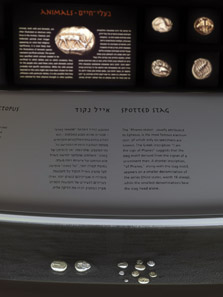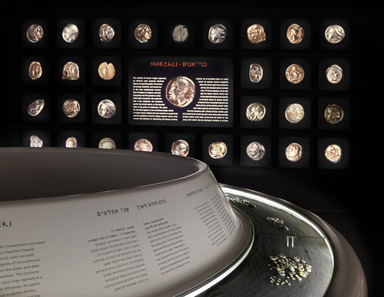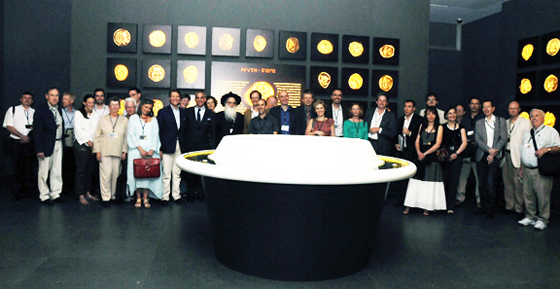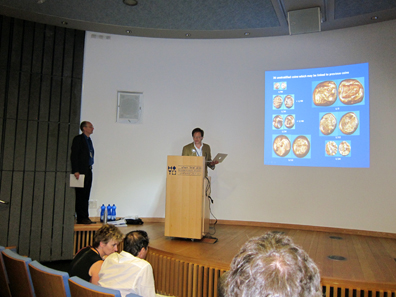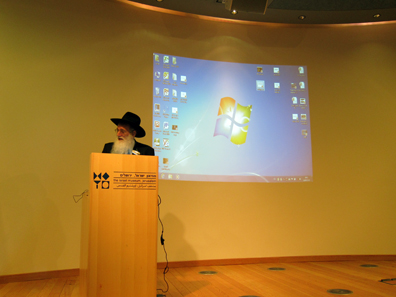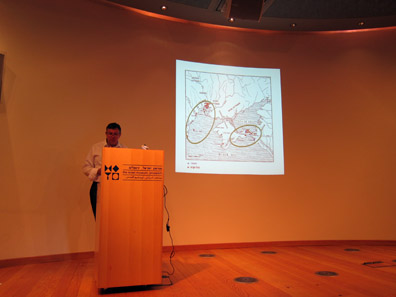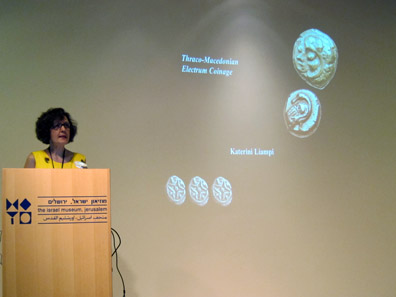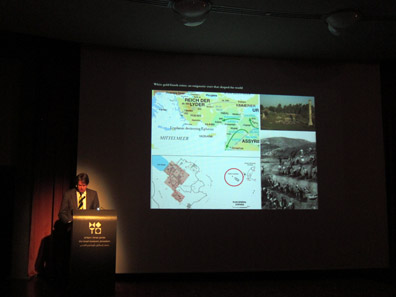by Ursula Kampmann
July 5, 2012 – Electrum coins own the charm of the archaic, early, crude, when they were struck for the very first time – well, when exactly was it, anyway? – in Lydia (or maybe rather in Ionia?). Whenever we speak of early electrum coins every specialist in numismatics will start stammering because they all know how rare clearly proved facts are in that field.
A glance into ‘White Gold’, the new exhibition of the Israel Museum. Photo: Israel Museum.
Who struck when, where and why the first coins? To the numismatist this question may be of peculiar interest while the amateur is rather captured by the beauty of these objects. And exactly on that relies Haim Gitler, the curator of the numismatic collection of the Israel Museum and responsible for the exhibition ‘White Gold’.
The showcase in the center of the exhibition. Photo: Israel Museum.
On all four sides the dimmed room shows blow-ups of the coins which are on display in its center. The showcase allures to look attentively. Resembling to the kind of case jewelers use it expresses non-verbally how valuable the objects are.
The blow-ups can be seen right from the place where the coins are on display. Photo: Israel Museum.
The pieces are exposed on graphite black sand. They come from two private collections compiled in the last years. The collectors, Dr Thomas S. Kaplan, his wife Daphne Recanati Kaplan and Baron Thyssen-Bornemisza, attended personally the exhibition’s opening. It is their collector’s dream that came true on the sand.
The Phanes stater, in the background blow-ups of the shown coins. Photo: Israel Museum.
Indeed not only the famous Phanes stater is on display, but in addition the trite, hekte and other fractions, too. Now, here lies the enigmatic stater from Phocaea offered at Triton in 2003. Its image is unique: a seal eats an octopus.
On top row of the blow-ups in the middle you can see the controversially discussed stater showing two athletes. Photo: Israel Museum.
Now finally a second stater has appeared showing the two athletes who hold a cantharus between them. Surely this will revive the discussion about the only other specimen known until now, which has been discussed very controversially.
A look into the showcase. Photo: Israel Museum.
And then the rich sampling of coins from Cyzicus. One grasps the beauty of these issues and the die engravers’ capability, only when looking not just on one single coin but on a whole pile of them.
The participants of the congress in the exhibition. Photo: Israel Museum.
Of course the participants gathered from 14 nations to attend this really international congress were excited about the exhibition, too. Haim Gitler and Catherine Lorber had assembled a group of them that gave reason to expect an epochal event even before the congress started. And indeed there was one academic sensation after the other.
Koray Konuk during his lecture. Photo: UK.
Koray Konuk for instance succeeded in photographing the coins from a hoard at the Artemision. Previously there had been available only images of very low quality in a rather dated publication, although these coins are of decisive importance to the determination of when the early electrum coins were struck. Mr Konuk gave a lecture together with Michael Kerschner of the Austrian Archaeological Institute on details of the site of find and the coins separating the facts with precision. Finally! Those who had dealt with the subject were until now confronted with a whole heap of completely different theories. Based on the facts these two scholars argue in favor of a beginning of electrum issues in the second half of the seventh century. They also made clear that it is quite probable that electrum coins played a role during the foundation ritual of parts of the building of the Artemision.
David Schaps conducts the first session of the second day. Photo: UK.
Anyway, these were not the only sensational news. Almost with their mouth open the visitors listened to Nick Cahill, member of the excavation team at Sardes, when he pronounced that neither in the river Pactulus nor in the gold mines nearby they had found any electrum at all. In Lydia there is only gold. Electrum might have come from other mines, as for example nearby Pergamum controlled by the Lydians at that time.
Mariusz Mielczarek of Nikolaus Kopernikus University in Thorn. Photo: UK.
Or let’s recall the very reasonable suggestion made by Bob Wallace from Northwestern University to not take too seriously the twice seven years of reign of Croisus as referred by Herodotus. According to him we have to date the beginning of Croisus’ reign to the years around 585/80, a suggestion that matches much better with the results of the excavation at the Artemision. There indeed archaeologists had always wondered how Croisus might have conducted this gigantic building project in the course of so short a lapse of time.
Katerini Liampi of Ioannina University / Greece. Photo: UK.
Besides these very fundamental questions many labor-intensive detail problems were solved as well. Just to cite an example, the question of to what extent electrum was struck in Thracia and Macedonia. Or Wolfgang Fischer-Bossert, who called the attention to the fact that a chronological order of the electrum coinage might be possible by analyzing the reduction of the weight standards. And over and over people wished a comprehensive die analysis.
Francois de Callatay during the evening lecture. Photo: UK.
During the evening lecture on the eve of the exhibition’s opening Francois de Callatay summed up the result in a very ironical fashion as follows: We are confused, but on a significantly higher level.
The participants of the congress in front of the Shrine of the Book. Photo: UK.
Indeed there are many questions not yet answered which require future research. At least things have been put on the right track. Soon the results of the congress will be published. And those who cannot wait until then should refer to other publications on the subject.
The exhibition has its own internet website where the coins on display can be admired in all their beauty. To get there, follow this link.
On how it happened anyway that the first issue of coins became reality the exhibition team realized a funny animation. Don’t miss it! To watch the cartoon, please click here.
Unfortunately the gorgeous catalogue of the exhibition featuring splendid images is not yet available through the online museum shop. But hopefully this might change soon…
Hence this is the link to the online museum shop.
And this is the website of the Israel Museum.
And by the way, the Dead Sea scrolls are now online. To see them, simply click here.




